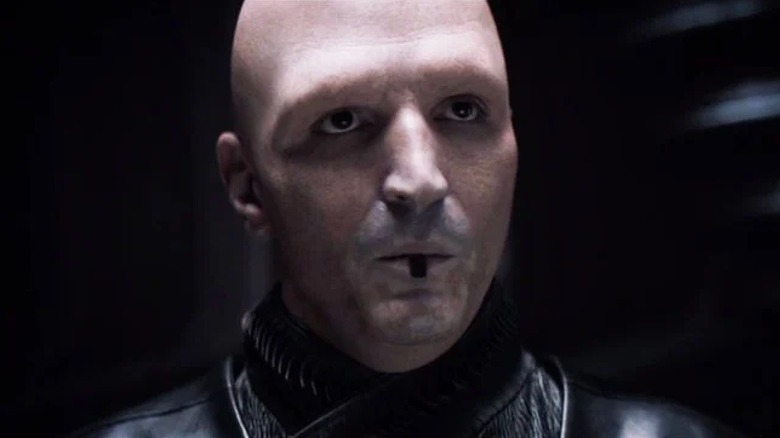What The Lip Tattoos In Dune Really Mean
Denis Villeneuve's "Dune" is finally here. And after an impressive opening weekend box office take (per Box Office Mojo), it's clear both fans and critics alike are enamored with the film's epic scope, and its trippy, beyond imaginative narrative (via Rotten Tomatoes). Perhaps more than any sci-fi film of late, "Dune" is the one which genuinely transports viewers to a grande new world full of sights to behold. That world is the desert planet known as Arrakis, which holds the universe's largest cache of "spice," the most coveted, and important element in the galaxy. Into that dusty, computerless landscape, the members of the Noble House Atreides are dispatched to protect the planet's vast stores of the vital substance, only to find treachery afoot on the galactic political front, and their house potentially in peril from forces both on and off-planet.
As one might expect, the film's vast narrative landscape is also populated by characters and creatures almost too numerous to track. Some of them are, understandably, more memorable than others, however. And it's safe to say the insanely intelligent House advisers Thufir Hawat (Stephen McKinley Henderson) and Piter De Vries (David Dastmalchian) are among the most notably unusual characters in the film — if only because of the thin black tattoos spotting their lower lips. Here's what those lip tattoos are all about.
The lip tattoo designates a very specific sort of character in the Dune universe
While Denis Villeneuve's epic never fully details what those markings are all about, they do carry a very important meaning in the "Dune"-iverse. Specifically, they denote a very particular sort of character in that universe. They're known as Mentats, and they're essentially human computers capable of unfathomable calculation and insight. And as anyone who's ever read the source material which inspired "Dune" (Frank Herbert's iconic novel of the same name) knows, those tattoos aren't exactly tattoos.
In fact, in Herbert's books, they're more of a stain, and far less specific to the lower lip area. As for what's "staining" the Mentat's lips in both iterations of the story, it's a substance called the Juice of Saphor, and it's a sort of a hyper-potent stimulant that greatly amplifies the mental capacity of those who ingest it. Of course, it's also a highly-addictive substance with several side effects, one of which is the staining red of the user's lips and mouth.
In both Herbert's book, and David Lynch's infamous 1984 adaptation of "Dune," that staining is presented more or less like a wine or Kool-Aid stain around the mouth. As for the stylistic change in Villeneuve's "Dune," hair and makeup head David Mowat admitted in a recent Polygon interview, he was simply no fan of the wine-stained look, and turned instead to the tattoo effect as a more elegant visual solution. It's a stunning deviation indeed, but it's also one Frank Herbert himself might legitimately appreciate.

